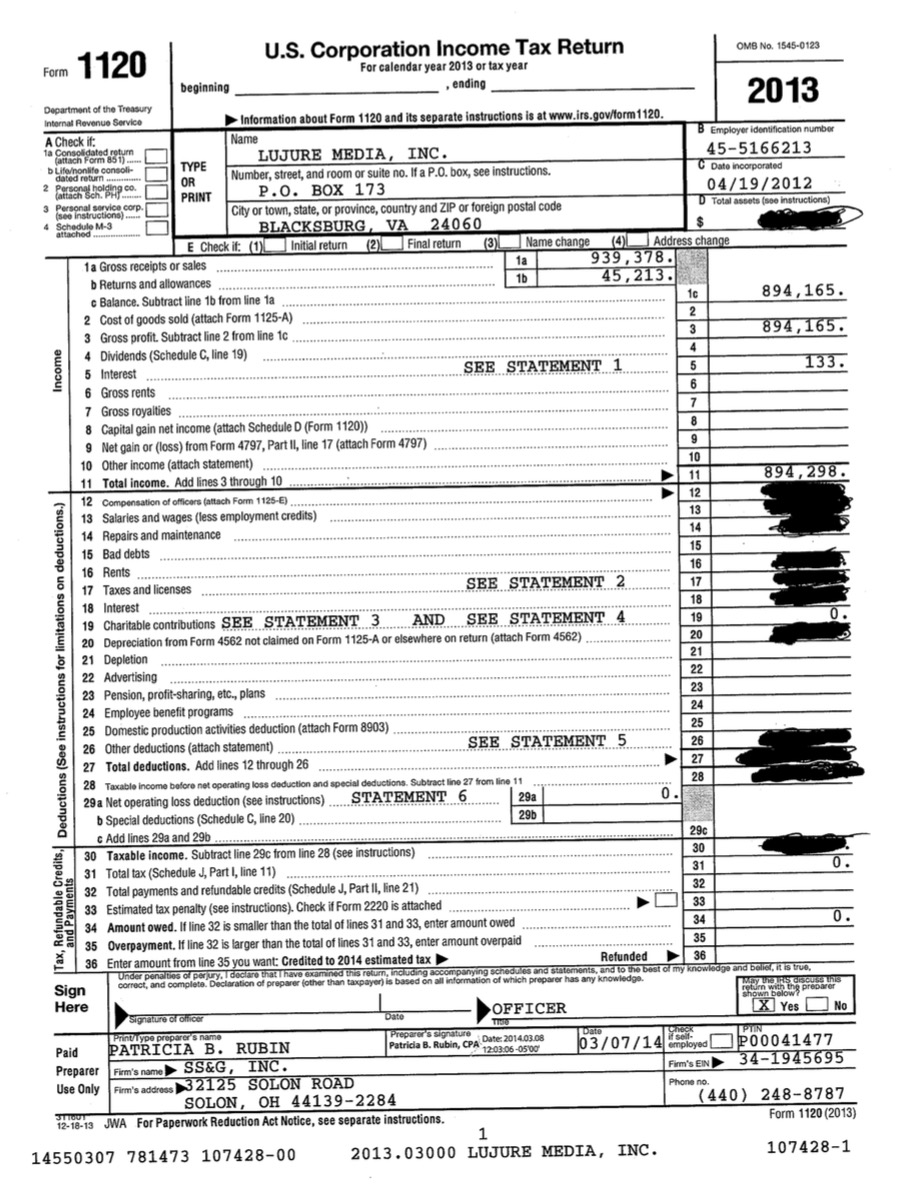The following is excerpted from “How to Be a Capitalist Without Any Capital: The Four Rules You Must Break To Get Rich” by Nathan Latka, in agreement with Portfolio, an imprint of Penguin Publishing Group, a division of Penguin Random House LLC. Copyright © Nathan Latka, 2019. For more information, visit capitalistbook.com.
You have to copy your competitors.
Do it now. Do it aggressively. Do it quickly. And do it by spending the least amount of money you possibly can.
When I was just starting my business in my dorm room at 21 years, old I copied one of our competitors’ platform and then added my own twist. That helped me reach $939K in sales much faster (and cheaper) than if I didn’t copy at all (and paid for all the mistakes my competitor had already learned with my own cash).
Here’s my 2013 business tax return if you want to dig deeper:
I constantly talk to people who won’t give themselves permission to copy. They think it’s unethical and that they have to invent something new if they’re going to launch anything. That’s where they’re completely wrong. Every successful entrepreneur has copied, even if they won’t admit it.
You usually just don’t notice it because they’ve taken someone else’s idea and tweaked it for an entirely different industry. Wealthfront CEO Andy Rachleff did exactly that to drive his customer base.
Wealthfront uses software, not people, to manage its customers’ investment portfolios. New investors get their first $10K managed for free. For every friend they invite who accepts, they get another $10K managed for free.
They’re the first company to bring this invite-a-friend model to the financial sector.
As Andy and I spoke over a spotty Skype connection, I asked how he came up with his growth model. His answer surprised me:
“We just copied Dropbox”
Dropbox gives users a certain amount of storage for free. Invite a friend who joins, and your free storage limit goes up. Sound familiar?
Fifteen percent of the invites that get sent out by Wealthfront’s customers lead to a new user who puts at least $500 into a new portfolio.
Blatant copying. No harm to Dropbox. Big win for Wealthfront.
When Facebook is on Snapchat’s tail copying every new feature, they’re clearly out to slay them. But it doesn’t have to be that way. Sometimes copying is just research. You’re seeing what works and what doesn’t so you can be hyper efficient with your resources. By the time you’re done with your product—or whatever you’re launching—it may look nothing like the competition you’ve shadowed. Or maybe it will. It’s your call.
Related: 5 Genius Insights to Start a Lucrative Side Hustle
How to decode a winning pattern to copy
I told you I’m obsessed with patterns. Finding the patterns that link successful businesses is like decoding the secrets behind a win. That’s essentially what you’re doing when you’re copying—you’re looking for the patterns that got your competitors to the top. Then you’re using that information to match or beat them. When you do this, you’re essentially getting a free business lesson. If you don’t copy these free lessons, you’ll have to do what those with less knowledge do: pay to learn the lessons yourself.
If you’re just starting out with a side hustle, the opportunities for copying are huge. Let’s look at Airbnb rentals, or, really, any product or service you’d offer through an online marketplace. All of your competitors’ strategies are laid out right in front of you. Scroll through the top-rated listings in your area and find the patterns they share.
If you’re doing Airbnb, start with the headline. How are the rentals with loads of ratings described? As I’m writing this, the top search results in Denver, each with more than 200 five-star ratings, have these headlines:
- 1880s Carriage House in Curtis Park
- Colorful & loving Denver Condo
- live like a local in trendy rino
- five star—2 miles to Downtown—free Parking—near Zoo
These clearly tell you what draws people in: fun or convenient location, historic charm, lively living space, etc. Think of your property in these terms and highlight the qualities that people will want.
Look at the pictures. How can you make the first picture in your listing stand out against a competitor’s? Sometimes you’ll want to copy, sometimes you’ll want to do the exact opposite of what others are doing to make your listing pop.
Then the description: How do they describe the Wi-Fi? Do they say: “Wi-Fi perfect for business professional,” or “Wi-Fi perfect for streaming YouTube videos while you party with your friends”? Are properties that are obviously old being pitched as “rustic” or as having “farmhouse charm”? Zero in on the lexicon these top listings use so you can cater to the same market they’re reaching.
Sign Up: Receive the StartupNation newsletter!
Any online marketplace is a gold mine for free business lessons. Another popular one for side hustlers: Etsy shops. Let’s say you want to launch a new women’s tank top. Go to…
- Etsy.com
- Clothing & Shoes
- Women’s Tops & Tees
- Tanks
…and see what patterns the most popular sellers share.
You can quickly see that tanks with cheeky sayings are huge sellers. As I’m writing this, a tank that says “Feed me tacos and tell me I’m pretty” has 2,941 reviews. If you search for just that phrase, you’ll see the copying on this one is fierce. At least five different sellers offer a shirt with the same saying, all with more than 500 reviews. Anything referencing coffee, wine, cats or yoga is huge.
Also look at style. As I scroll through, a lot of the bestsellers are white text on a black shirt.
Keep digging as you think up strategies for your own product. If you don’t already have a shirt idea, you can join the pretty taco party and do it better: lower prices, more color offerings, custom lettering, etc., depending on your capabilities. Or pull details from several of the most popular items and launch a version with your own twist: A cat sipping wine while doing a yoga pose?
Find an artist on Fiverr or Upwork to create the design for you (if you can’t do it yourself), crunch numbers to find an affordable vendor to print your shirts (if you don’t do it yourself), and you’re on your way.
I don’t want to underestimate the work that goes into creating a successful Etsy (or any other online) shop because it does take a ton of effort to get your products noticed and turn a profit. You likely won’t become a millionaire doing it. But you can make the long road to a steady income stream much shorter through strategic copying.
“How to Be a Capitalist Without Any Capital: The Four Rules You Must Break To Get Rich” is currently available for pre-order and will be released on March 5, 2019.







